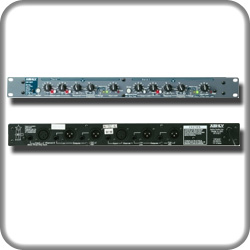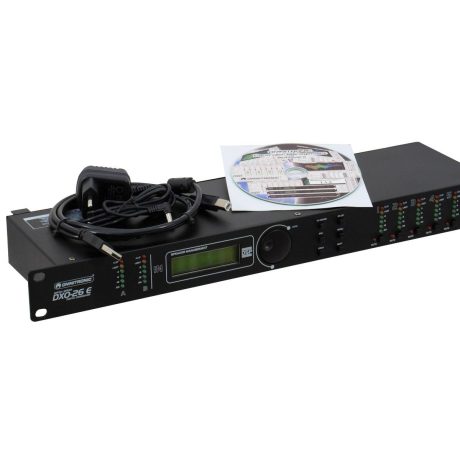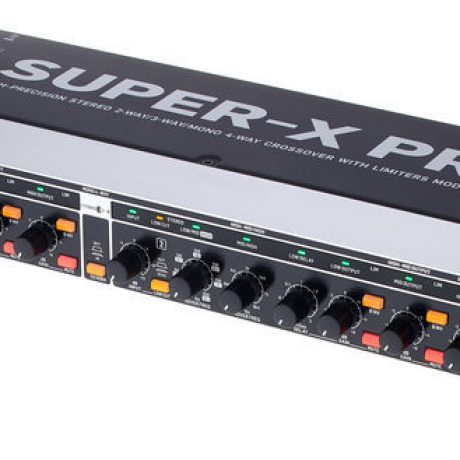| Content |
The XR-Series crossovers are the product of an intensive research effort started in 1972 which combined a reexamination of traditional crossover theory with practical field use. Over the years, a number of refinements and new models have been added to our crossover series, but the original design goals have remained the same: to produce a crossover which is sonically accurate, is flexible enough to suit a wide variety of systems, and affords maximum protection for speakers and drivers.
All Ashly crossovers are based upon the same powerful state-variable filter circuit, which guarantees that two adjacent frequency band outputs always remain in phase. Our crossovers offer a number of useful and unusual features, including continuous tuning, a response control, and a unique output stage which maintains low noise at any level setting. These models also include a 200:1 tuning range, output mute switches, and both TRS and XLR connectors. Like other Ashly products, your crossover features low noise and distortion, active balanced inputs, a peak level indicator, a precision regulated power supply, protection against abnormal input or output conditions, and rugged mechanical construction. Conservative design and an unusually thorough procedure for quality control have earned Ashly a reputation for dependability in the recording, sound reinforcement, and broadcast fields.
Response Control an Ashly Exclusive...
This control, found adjacent to the crossover frequency control, adjusts the damping of the filter affecting the response shape of the filters at the crossover point. The dial calibrations refer to the amount of attenuation effected by the filter at the crossover frequency, i.e., a setting of 3dB means that the filter's high-pass and low-pass outputs are each "rolled off 3dB at the crossover point“. This describes Butterworth filter response, or a gentle 3dB peak at the crossover point when the two filter output signals overlap. To obtain a flat signal, or "Linkowitz-Riley" response through the crossover region, set the Response control to "6“. This attenuates each output of the filter by 6dB at the crossover point (two identical signals added together yield a +6dB increase). To obtain a notch at the crossover point, turn down the response control past "6" to best suit your needs.
The purpose of this control is to help offset the inaccuracies inherent in typical loudspeakers, thereby helping you to achieve a flat system response. NOTE: The Response control is not a "slope" control. A 24dB/octave crossover will always have a slope of 24dB/octave. The Response control only affects filter response shape in the immediate vicinity of the crossover frequency; the ultimate crossover slope is a fixed parameter.
|
24dB/Octave Slopes |
|
Variable Filter Response Allows Tuning-In Linkwitz-Riley or Other Filters |
|
Output Mute Switches |
|
Balanced Inputs and Outputs |
|
20Hz Third Order High Pass Filter |
|
XLR and 1/4" TRS Audio Connections |
|
Peak Overload Warning LEDs |
|
Five Year Warranty | |
| Power supply: |
100-240 V AC, 50/60 Hz
6 V DC 800 mA |
| Power connection: |
Mains input via Coaxial power connector (M) mounting version power supply cord with AC adapter (provided) |
| Frequency range: |
10 - 30000 Hz |
| THD: |
<0,005 % at 1 kHz |
| DSP: |
Digital signal processor |
| Impedance: |
Input: 10 kOhm
Output: 50 Ohm |
| Gain: |
Output: -50 dB to +12 dB |
| Filter: |
Linkwitz-Riley; Butterworth; Bessel; 6db/oct; 12db/oct; 18db/oct; 24db/oct |
| Delay: |
0 - 5 ms |
| Dynamic range: |
Input: 114 dB
Output: 110 dB |
| Sample rate: |
67 kHz |
| Connections: |
Input: line via 2 x 3-pin XLR
Output: line via 6 x 3-pin XLR |
| Crossover frequency: |
20-20000 Hz |
| Max. level: |
Input: +22 dBu
Output: +9 dBu |
| USB port: |
Typ B |
| PC connect: |
DXO Software via USB, firmware can be updated |
| Housing design: |
(19") 48.3 cm rack installation 1 U |
| Dimensions: |
Width: 48,3 cm
Depth: 12,8 cm
Height: 4,45 cm |
| Weight: |
1,77 kg |
| Operating system: |
Win XP, Win Vista, Win 7, Win 10, OS X 10,5 or better |
|
Providing 48-bit filter algorithms, 24-bit AD/DA conversion and a dynamic range of 115 dB, the DSP 244 sets new standards for digital loudspeaker controllers and processors. The DSP 244 is an universal Digital Sound System Processor that provides 2 inputs and 4 outputs; plus internal summing of the inputs 1 and 2. Via matrix it is possible to assign the outputs to any input or to the sum of the inputs. It is further possible to establish the following configurations: Stereo or Dual 2-Way systems, 3-Way + Direct and 4-Way systems, each with Mono Subchannel, but also full range systems. High and low-pass filters are provided for the frequency crossover functions in all operation modes. The selection includes Linkwitz-Riley, Butterworth and Bessel type filters with switchable slopes between 6, 12, 18 and 24 dB/oct. A huge number of additional filters offers extremely flexible correction of the frequency response. Each input incorporates a 5-band equalizer, allowing to assign high and low-pass, high and low-shelving or parametric peak-dip filters to its individual filter sections. Next to the frequency crossover filters, four additional filters are employed in each output channel, which also can be set to work as high or low-pass, high or low-shelving filters, parametric peak-dip filters, or all-pass filters. Additional filtering is provided through 2. order high-passes for the realization of B-6 alignment, or special LPN-filters (Low-Pass Notch filters) for correcting the frequency and phase responses of optimally vented woofer cabinets. Each channel additionally provides a delay, a polarity switch, a programmable level control and a digital compressor / limiter while the master delays are located in the input channels. Datasheets / ManualsBrochure (309KB)
Mains voltage 90 - 250 V AC / 50 - 60 Hz Power consumption 20 watts Safety class I Inputs 2 x XLR IN, electronically balanced, transformer optional available 2 x XLR OUT (Direct Out) Input voltage (nominal) 1.55 V / + 6 dBu Max. input voltage 24.5 V / + 30 dBu Input impedance 20 kohms Common mode rejection > 40 dB AD-conversion 24-bit, Sigma-Delta, 128 times oversampling, linear phase Outputs 4 x XLR OUT, electronically balanced Output voltage (nominal) 1.55 V / + 6 dBu Max. output voltage 8.7 V / + 21 dBu Output impedance | Behringer CX-3400 3-Way Stero/4-Way Mono Frequency Crossover with Limiters
The CX3400 is an active frequency crossover enabling 2 or 3-way stereo or even 4-way mono operation. Each band features two 24-dB Linkwitz-Riley filters, as well as individual IGC limiters, while the integrated delay enables flexible time alignment. Polarity switches for each output allow quick and easy runtime compensation for various driver and horn types.2
Respectively:
3-Way stereo or 4-way mono
24 dB / octave Linkwitz-Riley filter
Mono-Sub switchable
LF / HF gain regular / mutable
CD horn EQ switchable
Vertex frequency tunable
Factor switching (10x)
Multi-band limiter switch / variable (threshold)
Limit display each way
LF Delay (max 2ms / 60cm)
Phase reverse
25 Hz subsonic filter, sym
XLR in / out with multiband limiters
Dimensions: 19", 1U, 147 mm case depth
Weight: 1.7 kg |
Lab Gruppen NLB 60E
The NomadLink network provides remote monitoring, control and power sequencing functions for multiple C Series or FP+ amplifiers. Indeed up to 16 NLB 60E network bridges, each monitoring up to 60 amplifiers may be accommodated in one system. Easy setup, redundancy, and minimum maintenance were bywords when developing this network format.
NomadLink is a closed-loop, daisy-chained network topology with the NLB 60E providing the bridge to the familiar world of Ethernet/LAN. NomadLink reduces installation time and cost significantly, includes redundancy during operation by design and simplifies the location of faults or system abuse.
NomadLink together with the associated DeviceControl software allows the subnets’ architecture to be automatically uploaded even without individual IP addresses in the amplifiers. All in all, it is the fastest and easiest monitoring and control network on the market today.
Specifications:
Network Connectors:
* Nomadlink Out: EtherCon housed RJ45
* Nomadlink In: EtherCon housed RJ45
* Ethernet rear-panel: EtherCon housed RJ45
* Ethernet front-panel: Standard RJ45
General Purpose Inputs (GPI):
* One Voltage sensing input: Two pole Phoenix
* Two contact closure inptus: Two pole Phoenix
Front Panel Indicators:
* Front operation locked: Yellow LED
* Fault warning: Red LED
* Amplifier subnet muted: Red LED
* NomadLink network connected/activity: Blue LED
* Ethernet connected: Orange LED
* Ethernet Activity: Yellow LED
2 x 16 Character display: White text, Blue background
Navigation and Adjust keys: Yes, x 6
Subnet Power on/off keys: Yes, x 2
Power: 100 to 240 VAC, 50 to 60 Hz (auto-select)
Power consumption:
Finish: Anodized aluminum front, Plated and painted steel chassis
Approvals: CE, CSA
Dimensions (W x H x D): 19" x 1.73" x 8.2" (483 x 44 x 208 mm), 1 RU
Weight: 5 lbs. (2.25 kg)
|
Based on a two-in, six-out topology, the DC-One is designed primarily for users of small-to-medium sized sound systems in both mobile and installed applications. While the unit is an all-new development based on a powerful SHARC processor, it is 100 percent compatible with all settings from other Electro-Voice signal processors. A large part of DC-Oneʼs development was aimed at ensuring that users can easily handle its serious digital horsepower and high-end audio performance. Free. PC-Editor software is available, or the DC-One can be operated via the front panel.
A/D Conversion 24-Bit Delta-Sigma
A/D Conversion 24-bit/sigma-delta (linear phase) 128 times oversampling
Analog Inputs 2 XLR (Electronically Balanced), 2 XLR THRU OUT (Electronically Balanced)
Analog Outputs 6 XLR (Electronically Balanced)
Control Protocol Front Panel USB Connector
D/A Conversion 24-bit/sigma-delta 128 times oversampling
D/A Conversion 24-Bit Delta-Sigma
Data Format 24-Bit
Digital Inputs 1 XLR AES/EBU (2 Ch)
Dynamic Range 111 dB (unweighted, band limited 22 Hz - 22 kHz)
Electronics Type Processor
FIR-Drive No
Frequency Response 10 Hz - 22 kHz (±0.5 dB)
Input Impedance (Balanced) 10 kΩ
Internal Processing 32-Bit Floating Point
Mains Voltage 100-240 VAC
Maximum Input Voltage 8.7 V / +21 dBu (Without -6 dB Analog Pad Engaged)
Maximum Output Voltage 8.7 V / +21 dBu
Nominal Input Voltage 1.23 V / +4 dBu
Nominal Output Voltage 1.23 V / +4 dBu
Output Impedance (Balanced) 50 Ω
Power Consumption 25 W
Sample Rate 48 kHz
THD+N < 0.01% (band limited 22 Hz - 22 kHz)
Height 1RU 44.45 mm (1.75“)
Width 482.6 mm (19“)
Depth 355.6 mm (14“)
Weight Net 4.6 kg (10.14 lbs) |

















Reviews
There are no reviews yet.